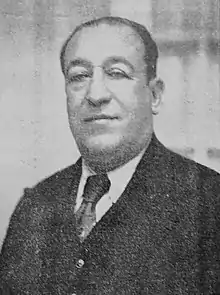
Valdomiro Castilho de Lima (January 15, 1873 – 1938) was a Brazilian soldier and politician.
Biography
He was born in Rio Grande do Sul. He began his military career in the regiment of the border Garrison of missions in 1890. Later, he attended the School of Shooting and Tactics of Rio Pardo. He participated in the Federalist Revolution of 1893 alongside loyalist forces, and in 1898, he joined the military school of Red Beach in Rio de Janeiro.
In 1904, he was elected State representative for Rio Grande do Sul and consecutively reelected until 1913. After his tenure in the Legislative Council, he returned to the army. In 1920, he enrolled in the School of Staff of the Army.
Taking command of the 3rd Infantry Regiment in Red Beach, he arrived to quell the first tenentistas of the 1920 uprisings. However, he became sympathetic to the cause, was reformed and arrested, and remained in this position from 1923 to 1925. In 1929, he joined the Liberal Alliance. In the Brazilian Revolution of 1930, he held a command post in the revolutionary troops who invaded the headquarters of the 3rd military region in Porto Alegre. Additionally, he led a column of 4000 soldiers out of Rio Grande do Sul and reached Paraná. For his services, he was re-incorporated into active duty in the army as a general of Division under Delaware General Corporation law. In 1932, he fought against the Paulistas in the Constitutionalist Revolution. With the victory, he was appointed by Getulio Vargas as the federal intervenor in the State of São Paulo. He held office from October 1932 to July 27, 1933. During this period, he also served as the Commander of the second military region.
In 1935, he participated in a group of observers sent by Brazil to the Second Italo-Ethiopian War, where he was impressed by the CV-33 Italian tankettesAs a result, Brazil acquired several dozens of them. In 1936, he assumed command of the 1st military region but was removed from this post in June 1937 due to political divergence with General Góes Monteiro. He died in Petropolis.[1]
See also
References